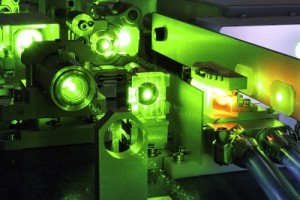 Click here for a printer-friendly version of this page.
Click here for a printer-friendly version of this page.
Objective You will learn about light waves and optics in this Laser Lab. Kids will play with their lasers and see what happens when they shine it on and through different objects.
Laser Safety Before we start our laser experiments, you’ll need eye protection – tinted UV ski goggles are great to use, as are large-framed sunglasses, but understand that these methods of eye protection will not protect your eyes from a direct beam. They are intended as a general safety precaution against laser beam scatter. (If you’re using a Class I or II laser, you don’t need to wear the goggles – but it is a good habit to get the kids into, so it’s up to you.)
About the Experiment This lab is an excellent opportunity for kids to practice asking better questions. Don’t worry too much about academics at this point – just give them a box of materials and let them figure these things out on their own. One of the neat things you can do is ask the kids some questions about what they are doing.
For example, when they shine their laser on a window, you’ll see part of the beam pass through while another part gets reflected back… now why is that? And why does the CD produce so many different reflections? Sometimes these reflections are hard to find actually seeing the beam itself. While red lasers are impossible to see with the naked eye, you can make your beam visible by doing your experiments in a steamy dark bathroom (after a hot shower).
The How and Why The word “LASER” stands for Light Amplification by Stimulated Emission of Radiation. A laser is an optical light source that emits a concentrated beam of photons. Lasers are usually monochromatic – the light that shoots out is usually one wavelength and color, and is in a narrow beam.
By contrast, light from a regular incandescent light bulb covers the entire spectrum as well as scatters all over the room. (Which is good, because could you light up a room with a narrow beam of light?)
There are about a hundred different types of atoms in the entire universe, and they are always vibrating, moving, and rotating. When you add energy to an atom, it vibrates faster and moves around a lot more. When the atoms relax back down to their “normal” state, they emit a photon (a light particle). A laser controls the way energized atoms release photons.
Imagine kids zooming all over the playground, a mixture of joy and chaos. Light from an incandescent light bulb works the same way – the bulb emits high energy photons that bounce all over the place. Can you round up the kids and get them to jumping in unison? Sure you can – just hit the play button on a song, and they’ll be clapping and stamping together. You can do the same with light – when you focus the energy into a narrow beam, it’s much more powerful than having it scattered all over the place. That’s just what a laser is – a high-energy, highly-focused beam of light.
Questions to Ask When you’ve worked through most of the experiments ask your kids these questions and see how they do:
- What does LASER stand for?
- How is a laser different from an incandescent bulb?
- What are two things that can split a laser beam?
- How do you make a laser beam visible?
- What’s the secret behind the laser light show?
- How do lasers damage things?
